SSZTA59 may 2017 ISOW7841
A couple of years ago, when I was working with interfaces in the industrial market, the size of the device package was never a showstopper. Fast-forward a few years, and device package size is sometimes a deciding factor as to whether you can use it in your application.
Industrial application functionality is increasing while size is decreasing, similar to the consumer market, but on a smaller scale. The challenge is now with semiconductor manufacturers to provide smaller package solutions without losing performance. This is true in the isolator space as well; but with isolators, there are certain dimension requirements for high-voltage creepage and clearance demands. But still smaller is better.
In my last post, I discussed the ISOW7841, which integrates isolated data and power in a single package and can replace the discrete solution (dotted section) shown in Figure 1.
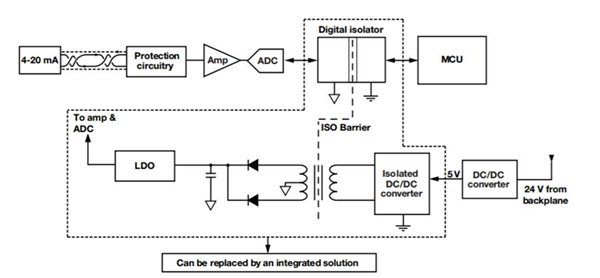 Figure 1 Isolated Data and Power
Subsystem
Figure 1 Isolated Data and Power
SubsystemThis integrated solution is smaller than the discrete solution which incorporates a transformer driver, transformer, rectifier and regulator (as shown in Figure 2).
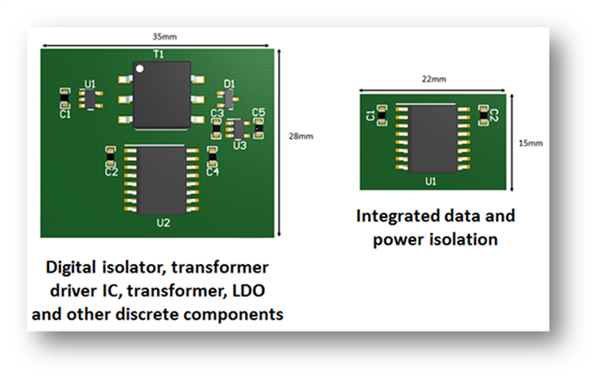 Figure 2 Size Comparison of Discrete
and Integrated Isolated Data and Power Subsystem Board Layouts
Figure 2 Size Comparison of Discrete
and Integrated Isolated Data and Power Subsystem Board LayoutsOn the left side of Figure 2, you can see the board layout with the discrete components needed to build an isolated data and power solution. On the right side, the design is simplified by just one component with two decoupling capacitors. The size of the design drops from 35 mm-by-28 mm to 22 mm-by-15 mm, around 33% of the discrete solution’s board space.
But is that the only savings you can expect from a single-chip solution? No. Here are some additional benefits:
- Board height. An external transformer can be bulky and often much thicker than small-outline integrated circuit (SOIC) packages. As Figure 3 shows, the discrete solution uses a 4.10-mm thick isolation transformer. The integrated solution with planar transformers in a 16-pin SOIC package (shown in Figure 4) has a thickness of 2.65 mm, which is about 35% smaller in height compared to the discrete transformer. When you want to stack multiple boards in space-constrained applications, the smaller height of the integrated solution will come in handy.
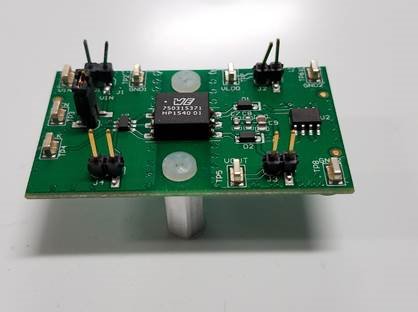 Figure 3 Discrete Solution for
Isolated Power with a 4.10mm-thick Isolation Transformer
Figure 3 Discrete Solution for
Isolated Power with a 4.10mm-thick Isolation Transformer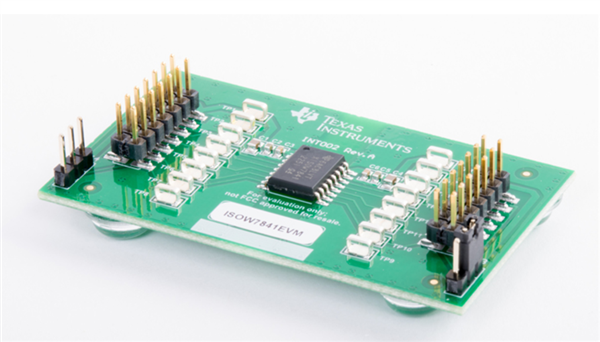 Figure 4 ISOW7841 Evaluation Module
with Planar Transformers in a 2.65mm-thick 16-Pin SOIC Package
Figure 4 ISOW7841 Evaluation Module
with Planar Transformers in a 2.65mm-thick 16-Pin SOIC Package- Certifications. Almost all designers get their systems certified by agencies such as Underwriters Laboratories (UL), Verband der Elektrotechnik (VDE), etc. These certifications require that components on the board meet the prescribed standards. Having a discrete solution not only adds to the number of components requiring certification, but it may also delay the process if any of the certified components are unavailable. For example, it may be difficult to find a transformer with the right certifications, especially with reinforced ratings. An integrated chip simplifies this process because the isolated signal and power solution is certified as a single unit. Every TI isolator is certified by agencies like UL, VDE, Canadian Standards Association (CSA) and TÜV SÜD. Most certifications are available within six months of device release.
- Simplicity. Systems involving an isolated power supply need protection from overloading and short circuits. For instance, a malfunction of the circuit and possibly increased device temperatures will occur if the voltage drops due to the load and the current continues to rise. Having overload-protection features like thermal shutdown and current limiting will prevent damage to the device and circuit.
Another feature that is nice to have in isolated power supplies is the soft-start mechanism, which ensures controlled in-rush current and avoids any overshoot on the output during power up. Figure 5 compares the VCC and output voltage VISO waveforms of the ISOW7841 with a similar device on the market. Any overshoot at the output could potentially damage the load circuits. The soft-start scheme in the ISOW7841 limits primary peak currents drawn from the VCC supply and charges the VISO output in a controlled manner, avoiding overshoots.
These features (thermal shutdown, current limiting, soft-start) in the ISOW7841 device reduce the amount of external protection circuitry in the design, thereby simplifying it.
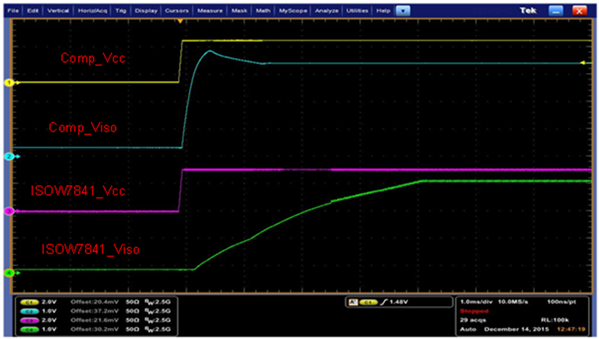 Figure 5 VISO Power-up
Oscilloscope Capture Compares VISO Waveforms of the ISOW7841 with a Similar
Device on the Market
Figure 5 VISO Power-up
Oscilloscope Capture Compares VISO Waveforms of the ISOW7841 with a Similar
Device on the MarketThe next time you are looking for space-saving isolation devices, look at more than the device’s XY dimensions. Additional device benefits may make your design smaller and your time to market faster.
Additional Resources
- Check out the ISOW7841 data sheet.
- Watch the video, “Reinforced Isolation and Power: An Integration Story.”
- Download the white paper, “Fully integrated signal and power isolation – applications and benefits.”
- Learn more about designing with low emissions in the article, “How to achieve low radiated emissions with fully integrated data and power isolation.”